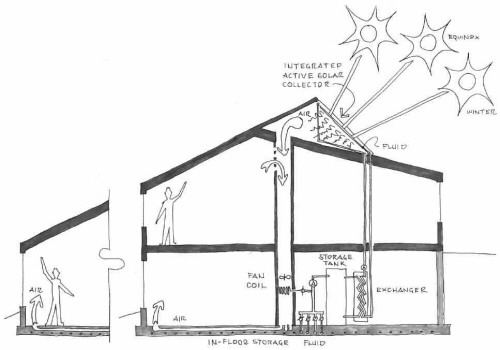All sites are not created equal. While the full benefits of passive solar can only be gained with an unobstructed southern exposure, many sites offer less. Of course, solar is only one consideration, and not necessarily the most important. To get the most out of it, you will have to plan your site.
Site planning requires knowing your site. Spend some time there during all parts of the day and in all seasons. Imagine living there. Know where the sun rises and sets, and how much access you have to it in winter. What is the microclimate, prevailing seasonal winds, rain, snow and storm directions? What is the topography, slopes and their direction, soil type, water runoff and water table, and plant life? How can all of these be modified for access, outdoor areas, disposal fields, wells, power lines, etc.? All of these considerations should tell you where your house should be located, the pattern of its layout and its geometry. Design you lot first, then design your house for the lot.
North views and slopes restrict solar access, especially for passive solar. To compensate for this lack of energy gain, we enhance energy conservation.
Minimize Northern Exposure, the high heat-loss face of the house, by keeping a low roofline and by setting the house into the ground, employing earth berming. [ See Diagram 1 ]
Diagram 1:
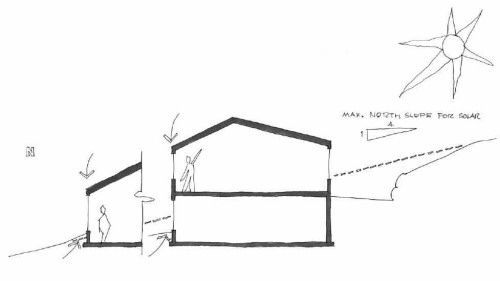
Minimize North Facing Glass, the highest heat-loss component. North views can be seen out through corners allowing some of the glass to face east or west. You do not need to see square out the glass to obtain a particular view.
This also allows early morning or late afternoon light to enter the house. Open plans allow sharing the view from the same window with several spaces. [ See Diagram 2 ]
Diagram 2:
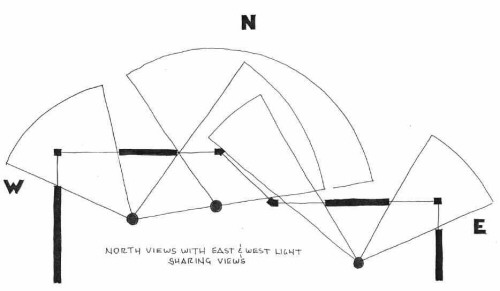
Daylighting your home has surprisingly little to do with how much glass you use. It has everything to do with orientation [allowing the sun in a various times of the day], with penetration [allowing the sun to penetrate deep into the building], and with what you do with that light [bouncing it around off reflective surfaces or diffusing it with shear drapes or blinds]. Centering windows and skylights minimizes reflected light.
Since glass is expensive, it is nice to know that you do not need a lot of it to get a lot of light. In addition, some of this glass may be oriented to give you some passive solar gain.
Maximize light by space planning and window placement. Remember that buildings create semi-enclosed outside spaces like courtyards. [ See Diagram 3 ]
Diagram 3:
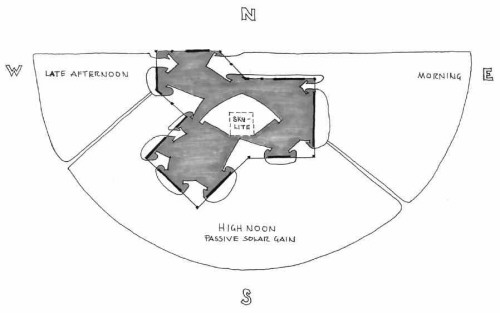
Maximize Light by your building geometry, using skylights and clerestories. [ See Diagram 4 ]
Diagram 4:
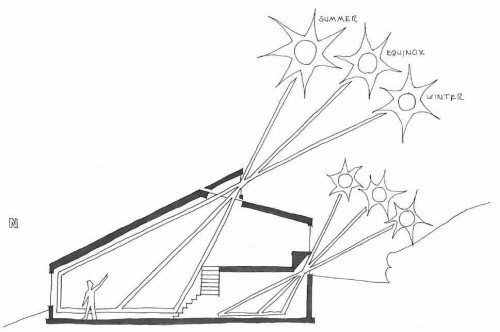
Passive Solar should be inherent in your design. The steeper the north slope, the more difficult this becomes. Solar gain through the walls of south facing courtyards may require difficult and expensive site modifications. Solar gain through the roof with skylights and clear-stories require the ability to move and store this heat. Indeed, if you have limited passive solar and any access to the sun in winter, you can also incorporate active solar to increase the amount of energy available.
Active Solar uses a collector to absorb the suns energy and then transfers this energy by air or liquid or both. The collectors can be integrated into the house geometry or even mounted remote from the house if this is necessary to access the sun. Active solar is predominately used for hearing your domestic hot water where the strong summer sun needs only a small collector. To capture a lot of heat from the weak winter sun, a much larger and thus more expensive collector is required. Relying on active solar for a significant proportion of your heating becomes expensive and you will have enough surplus heat in the summer to heat a fair-sized swimming pool or to provide hot water from your neighbours. A compromise approach is to oversize a domestic hot water system which will give you some space heat late in the winter while adding minimally to the cost. There are several approaches to integrating active solar into your space heating system. [ See Diagram5 ]
Diagram 5:
